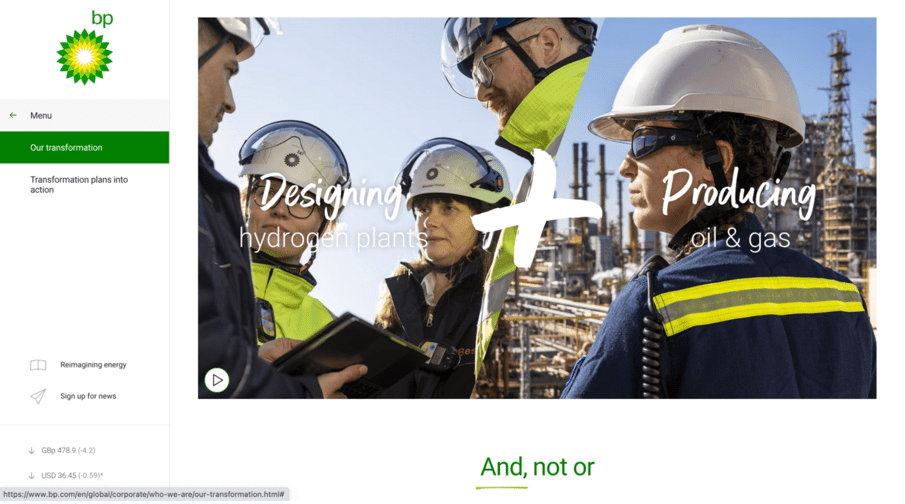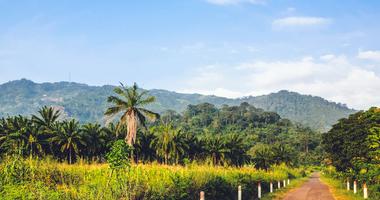
Big Oil is Trying to Sell a False Narrative About its Sustainability
Using misleading ads, Big Oil creates distractions and even outright lies about their positions on climate change, attempting to convince people they are making changes to respond to this global crisis.
For decades now, major oil companies have been spreading doubts about clean energy and climate action. Now, they’re using their advertising power for what’s known as greenwashing, or the misrepresentation of how sustainable a company is. This misleads the public into supporting them rather than holding them accountable for their inaction.
You may have heard of this in reference to clothes, food, or other products, but some of the biggest culprits of greenwashing are oil companies. They’re responsible for the fossil fuel use that is contributing to the terrifying increase in extreme heat, storms, floods, and wildfires we’re seeing around the globe. Yet while communities suffer from the effects of their carbon-heavy energy, Big Oil is dodging the blame and even masquerading as supporters of clean energy. These tactics help them delay real steps towards the clean energy transition and continue down their destructive path, protecting their all-important profits.
A study found that five of the major oil companies - ExxonMobil, Shell plc, Chevron Corporation, BP plc, and ConocoPhillips Company - spent nearly $3.6 billion combined on advertising between 1986 and 2015, trying to clean up their appearance. Notably, higher years of spending matched up with years of congressional activity on climate change and high media coverage of the issue.
These advertisements appear everywhere on billboards, browsers, news sites, print, social media platforms, podcasts and TV, pushing their way onto people’s screens and into the public conscience. Using them, Big Oil creates distractions and even outright lies about their positions on climate change, attempting to convince people they are making changes to respond to this global crisis.
After all, if the public believes they’re taking action, they succeed in their goal of continuing to rake in profits undisturbed. Profits, which by the way have been record-breaking amidst our record-breaking heat. While they’re pocketing all that money, their dirty product is leading to almost $900 billion annually in economic damages related to the climate crisis.
Let’s take a look at a few of those greenwashing ads and dive into the appearance vs. reality. What are they really saying? What are they hiding? How much of it is lies?
Take for example this Chevron ad seen in an Axios Generate email newsletter:

Appearance: Chevron cares about people and the planet. They’re lessening their carbon emissions and funding clean energy.
Reality: Chevron has put a mere fraction of its record profits from oil and gas towards reducing emissions and intends to continue down the same path they’re on.
They claim they’re investing in the “fuels of tomorrow” (whatever that means!). But Chevron’s spending on low-carbon energy between 2010 and 2018 was 0.23 percent of their total capital expenditures.
As far as “cutting carbon intensity today,” Chevron’s goal to reach net-zero by 2050 doesn’t include anything about scope 3 emissions - the emissions from using their products and by far the largest segment of their emissions. This weak promise is only talking about operational emissions, like what they use counting all their money.
In fact, they’re doing exactly the opposite of backing off of fossil fuels. Chevron's plans are to increase their spending on oil by billions in 2023 and they’re on track to increase oil production through 2027.
Basically, they’re saying they’ll use slightly cleaner practices to produce the same (or more!) carbon-heavy fossil fuels. “Energy in progress?” More like energy for profit. There’s no progress being made there.

Appearance: ExxonMobil is leading cutting-edge research into potential future clean energy sources.
Reality: ExxonMobil is throwing a small sum, compared to their billions of spending, into fluke solutions to climate change to make it seem like they care about reducing emissions.
Nothing could be more obviously greenwashing than this glaringly neon-green ad run by ExxonMobil. It’s one of many that have flooded news outlets, TV, and Exxon’s website for over 10 years, bragging about their involvement in researching algae biofuels.
Exxon claimed these farms of genetically modified algae could someday power planes, ships, and trucks, cutting these transportation emissions in half. An optimistic goal despite many concerns over the feasibility of large-scale algae production that reveal it to be a weak (at best) climate solution.
But algae was surprisingly low on Exxon’s priority list despite how much more they promoted it over the actual work they do with fossil fuels. Since 2009, when they first advertised their work with algae biofuels, Exxon has spent more on corporate advertising than on their algae research.
And now they’ve given up on it completely. That’s right. It was revealed in February of this year that Exxon quietly withdrew funding for their algae biofuel project in December of 2022. With it goes the supposed commitment to low-carbon energy the company has been riding on for a decade. This goopy green charade just goes to show how little we can rely on the word and so-called solutions of Big Oil.

Appearance: BP does it all, from fossil fuels to renewables, and will help us transition by utilizing all available energy sources.
Reality: BP still is a majority fossil fuel company and the idea that they’re diversifying will enable them to maintain their reputation while slowing down a real transition.
BP’s need to improve its reputation is obvious with a certain disastrous oil spill in mind, but they often take it too far. In 2019, BP’s ad campaign “Keep advancing” and “possibilities everywhere” received backlash for being blatant greenwashing as the company excessively bragged about its low-carbon energy while spending over 96% on oil and gas. A complaint made by ClientEarth led BP to end the campaign and claim an end to “corporate reputation advertising” entirely (you can be the judge of whether that happened or not).
Now, you see all over their website mentions of their “transformation,” net-zero pledges (which they’ve rolled back), and low-carbon energy work. While BP claims to be transforming, it’s often touting oil and gas production at the same time as hydrogen plants, EV chargers, and wind farms like in this video (screenshot above). The message is “and, not or,” a slogan that ran in ads on Facebook in May implying we still need oil and gas even with clean energy sources. It aligns with a common narrative for BP that they do it all (like when they rebranded to “Beyond Petroleum”).
BP does more than their Big Oil peers in terms of low-carbon energy (which is like saying more than almost nothing). The page featuring the video states they increased investments in what they call their “transition growth engines” from 3% in 2019 to about 30% in 2022. Curious what’s included in these “transition growth engines?” Among other things - their convenience stores.
Narratives like this one BP is pushing are desperate attempts to keep Big Oil’s spot at the table as tides shift in support of the clean energy transition. But it’s clear, what BP means by their “transformation” is certainly not our transformation.
Conclusion:
Taking a look at the examples we covered, there are a few common tactics fossil fuel companies use in their greenwashing campaigns.
- Specifically worded and vague phrases like “low-carbon,” “fuels of tomorrow,” or “resilient hydrocarbons” allow them to get away with implying things that simply aren’t true.
- Weak climate solutions like biofuels, carbon capture, or fossil fuel-based hydrogen that distract from the real ones like wind and solar.
- Promises that sound good being announced that they later quietly back out of, ensuring they get good publicity without taking real action.
- And of course, the strongest tool in their belt – outright lies.
Next time you see a green-colored, sustainable ad from big polluters like Chevron, Exxon, BP, or Shell, keep these strategies in mind and don’t take it at face value. And don’t forget to share it with us so you can help us continue to call out Big Oil’s lies.




